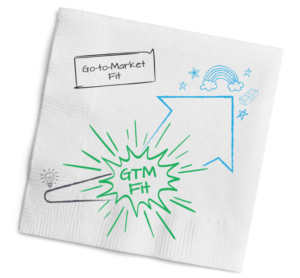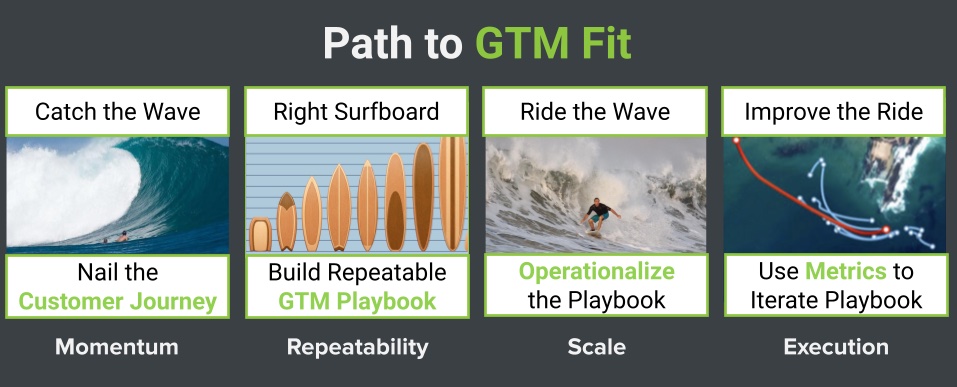
What is GTM Fit?
So what is GTM Fit? What’s a metaphor for GTM Fit? GTM Fit is the difference between paddling and surfing. Paddling is painful. Surfers expend a tremendous amount of energy paddling for relatively little progress. Without GTM Fit, start-up companies struggle to win deal by deal, spending lots of cash and energy. Tensions run high as growth and expansion is difficult, repeatability is missing, and everyone stares at the rapidly impending zero cash date.
Once you find GTM Fit, you’re no longer paddling for your life. You’re surfing a wave with lots of leads where deals convert and repeatability is visible. For every dollar you put into sales and marketing, you get more than a dollar out. In other words, it’s pure momentum.
When to Look for GTM Fit
Start by paying close attention to customer behaviours: what got their attention; why do they spend time with you; who commits and who doesn’t; who moves fast and slow; why did they buy and why did they not; and who actually makes the purchase decisions. The mixture of positive and negative data points are hugely valuable market signals when it comes to strategies for growing start-ups and finding GTM Fit.

Why Does GTM Fit Matter?
Okay, surfing instead of paddling sounds all well and good — but do you really need GTM Fit to do that? Isn’t it enough to just scale up? Yes, that is if you want to waste a lot of time and money!
Spending your way to GTM Fit by hiring more sales or investing more in marketing rarely works. Without urgency and a repeatable start-up growth recipe to find and win deals, increasing sales and marketing spend is like throwing money against the wall.
The pressure to hit the gas on sales and marketing will be enormous, but don’t do it until you can see the repeatable GTM playbook and GTM Fit. Setting an explicit GTM Fit milestone with the board and the leadership team will help everybody manage expectations and create focus. Once you have GTM Fit and feel the momentum, then it’s time to hit the gas on the expansion strategy.
Finding GTM Fit is hard. The stakes are high. The search is stressful. It creates cultural and organisational changes, as GTM becomes as important as a product. At the same time, it allows you to win customers, and that’s energising. Seeing patterns emerge that can be repeated makes everybody in the company realise that they’re not crazy. Hiring grade-A talent becomes much easier. You pick up momentum, and it’s a blast.
The 4 Steps to GTM Fit
- Catch the Wave: Nail the Customer Journey — and you harness lots of momentum.
- Build the Right Surfboard: Create a Repeatable GTM Playbook — and you get repeatability.
- Ride the Wave: Operationalize the Playbook — and you can scale the GTM.
- Improve the Ride: Iterate with Metrics — and you can improve GTM execution.

As you follow the path to GTM Fit, each step builds on the last for growth hacking strategies, mapping onto what you’ve done before. When you reach the end, you’ll be able to see how everything fits together. If it sounds intimidating now, don’t worry. We’re going to take things step by step.
You can’t surf if you don’t catch the wave. But it’s not enough for surfers to find a wave — they need to read it, too. Is it a beach break, a reform wave, or a double-up? The structure of the wave will determine the surfer’s approach.
Identify Urgent Pain for the Ideal Customer Profile
For the enterprise start-up, finding the wave means identifying the Urgent Pain for the Ideal Customer Profile that drives customers to buy now. The wave starts with the Urgent Pain for the Ideal Customer Profile and ends when your company becomes strategic to the customer. This is especially critical for SaaS start-ups, since signing the contract is only the beginning of the relationship with the customer, and so much of the business is based on renewals and upsells.
The Customer Journey (CJ) is also the backbone of your entire Go-To-Market. Everything else is built on top of it. Nailing the CJ means: starting with the Urgent Pain, working out the full CJ – including the 7 Key Milestones, winning first customers and ending by becoming strategic to the customer.
Let’s start with the first part. Without an Urgent Pain, there is no GTM Fit. Period. Growth will be slow and painful. Why? Urgent pain drives leads. This is a start-up growth strategy example. Urgent pain drives customers to engage. Urgent pain drives customers to decide to buy. Urgent pain drives customers to buy new products from new companies, vs legacy vendors. But most importantly, the urgent pain answers the question:
“Why buy now, versus a year from now?”
If you can’t answer that question, you do not have urgency. It’s that simple. Without a clear urgent pain, why should the customer put their reputation on the line to buy a new product from a new company? Or maybe they do engage with you, but it’s endless educational meetings and a never-ending sales cycle. Why should they even bother to spend their valuable time engaging with you at all?
Usually, the urgent “why now” problem won’t feel like a sexy way to disrupt the status quo. But finding this pain is important for the expansion strategy because it creates the entry for the enterprise start-up, and motivation for immediate customer action. And by addressing an urgent pain for your Ideal Customer Profile (ICP), you can methodically find and catch the wave of momentum.